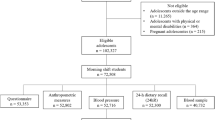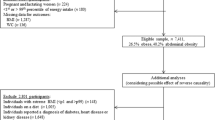Abstract
Background:
Pre-prepared commercial foods (convenience foods, CFs) are one aspect of modern dietary habits. The present paper examines the association between CF consumption and dietary quality or body weight status in a sample of German children and adolescents.
Methods:
Linear mixed-effect regression analyses using data from 586 participants (296 boys, 3–18 years) in the Dortmund Nutritional Anthropometric Longitudinally Designed Study, who yearly completed 1890 3-day dietary records and anthropometric measurements in 2004–2008, was used.
Results:
CF intake (percent total food intake) showed no significant association with macronutrient intakes (%E), with exception of a significant positive association with polyunsaturated fatty acid (PUFA) intake (P<0.0001). Considering only high-energy-dense (ED)-CF (40% of the CF intake), there was a significant negative association with total protein, carbohydrate and saturated fatty acid intake (%E) (P<0.05), and a positive with total fat and PUFA (P<0.01). The nutrient quality index (harmonic mean of 10 vitamins and minerals as the percentage of the reference intakes) showed a significant negative trend with increased consumption of CF (P=0.0013). No significant association between baseline or change in consumption of CF and baseline or change in parameters of body weight (standard deviation score of body mass index (weight/height2) or percentage body fat (%BF) estimated from skinfolds) was found. Among boys, baseline consumption of high-ED-CF significantly predicted change in %BF during the study period (β 0.104, P=0.0098).
Conclusions:
Our results point to an impairment of dietary quality with high consumption of CF and to a small but positive association between consumption of high-ED-CF in boys and weight.
This is a preview of subscription content, access via your institution
Access options
Subscribe to this journal
Receive 12 print issues and online access
$259.00 per year
only $21.58 per issue
Buy this article
- Purchase on Springer Link
- Instant access to full article PDF
Prices may be subject to local taxes which are calculated during checkout
Similar content being viewed by others
References
Ainsworth BE, Haskell WL, Leon AS, Jacobs Jr DR, Montoye HJ, Sallis JF et al. (1993). Compendium of physical activities: classification of energy costs of human physical activities. Med Sci Sports Exerc 25, 71–80.
Alexy U, Kersting M, Sichert-Hellert W, Manz F, Schöch G (1998). Energy intake and growth of 3- to 36-month-old German infants and children. Ann Nutr Metab 42, 68–74.
Alexy U, Sichert-Hellert W, Kersting M (2002). Fifteen-year time trends in energy and macronutrient intake in German children and adolescents: results of the DONALD study. Br J Nutr 87, 595–604.
Alexy U, Sichert-Hellert W, Rode T, Kersting M (2008). Convenience food in the diet of children and adolescents: consumption and composition. Br J Nutr 99, 345–351.
Benton D (2004). Role of parents in the determination of the food preferences of children and the development of obesity. Int J Obes Relat Metab Disord 28, 858–869.
Buckley M, Cowan C, McCarthy M, O'Sullivan C (2005). The convenience consumer and food related lifestyles in Great Britain. J Food Products Marketing 11, 3–25.
Cole TJ, Bellizzi MC, Flegal KM, Dietz WH (2000). Establishing a standard definition for child overweight and obesity worldwide: international survey. BMJ 320, 1240–1243.
Cornelisse-Vermaat JR, van den Brink HM (2007). Ethnic differences in lifestyle and overweight in the Netherlands. Obesity (Silver Spring) 15, 483–493.
Drewnowski A (2003). The role of energy density. Lipids 38, 109–115.
Ello-Martin JA, Ledikwe JH, Rolls BJ (2005). The influence of food portion size and energy density on energy intake: implications for weight management. Am J Clin Nutr 82, 236S–241S.
German Nutrition Society (Deutsche Gesellschaft für Ernährung, DGE) (2000). Dietary reference intakes [Referenzwerte für die Nährstoffzufuhr]. Deutsche Gesellschaft für Ernährung, Umschau: Frankfurt.
Johnson-Down L, Ritter H, Starkey LJ, Gray-Donald K (2006). Primary food sources of nutrients in the diet of Canadian adults. Can J Diet Pract Res 67, 7–13.
Kersting M, Sichert-Hellert W, Lausen B, Alexy U, Manz F, Schöch G (1998). Energy intake of 1–18 year old German children and adolescents. Z Ernahrungswiss 37, 47–55.
Kroke A, Manz F, Kersting M, Remer T, Sichert-Hellert W, Alexy U et al. (2004). The DONALD Study: history, current status and future perspectives. Eur J Nutr 43, 45–54.
Kromeyer-Hauschild K, Wabitsch M, Kunze D, Geller F, Geiß H, Hesse V et al. (2001). Perzentile für den Body-mass-index für das Kindes- und Jugendalter unter Heranziehung verschiedener deutscher Stichproben. Monatsschr Kinderheilkd 149, 807–818.
Libuda L, Alexy U, Buyken AE, Sichert-Hellert W, Stehle P, Kersting M (2009). Consumption of sugar-sweetened beverages and its association with nutrient intakes and diet quality in German children and adolescents. Br J Nutr 101, 1549–1557.
Libuda L, Alexy U, Sichert-Hellert W, Stehle P, Karaolis-Danckert N, Buyken AE et al. (2008). Pattern of beverage consumption and long-term association with body-weight status in German adolescents—results from the DONALD study. Br J Nutr 99, 1370–1379.
Livingstone MB, Robson PJ (2000). Measurement of dietary intake in children. Proc Nutr Soc 59, 279–293.
Malik VS, Schulze MB, Hu FB (2006). Intake of sugar-sweetened beverages and weight gain: a systematic review. Am J Clin Nutr 84, 274–288.
Milligan RA, Burke V, Beilin LJ, Dunbar DL, Spencer MJ, Balde E et al. (1998). Influence of gender and socio-economic status on dietary patterns and nutrient intakes in 18-year-old Australians. Aust NZ J Public Health 22, 485–493.
Northstone K, Emmett P (2005). Multivariate analysis of diet in children at four and seven years of age and associations with socio-demographic characteristics. Eur J Clin Nutr 59, 751–760.
Pryer JA, Nichols R, Elliott P, Thakrar B, Brunner E, Marmot M (2001). Dietary patterns among a national random sample of British adults. J Epidemiol Community Health 55, 29–37.
Pryer JA, Rogers S (2009). Dietary patterns among a national sample of British children aged 1 1/2–4 1/2 years. Public Health Nutr 12, 957–966.
Rodriguez-Artalejo F, Garcia EL, Gorgojo L, Garcés C, Royo MA, Martín Moreno JM et al. (2003). Consumption of bakery products, sweetened soft drinks and yogurt among children aged 6–7 years: association with nutrient intake and overall diet quality. Br J Nutr 89, 419–429.
Savage JS, Fisher JO, Birch LL (2007). Parental influence on eating behavior: conception to adolescence. J Law Med Ethics 35, 22–34.
Sichert-Hellert W, Kersting M, Chahda C, Schaefer R, Kroke A (2007). Commercial food products in a Food Composition Data Base for dietary evaluation in pediatric age groups. J Food Compos Analy 20, 63–70.
Slaughter MH, Lohman TG, Boileau RA, Horswill CA, Stillman RJ, Van Loan MD et al. (1988). Skinfold equations for estimation of body fatness in children and youth. Hum Biol 60, 709–723.
Swinburn BA, Caterson I, Seidell JC, James WP (2004). Diet, nutrition and the prevention of excess weight gain and obesity. Public Health Nutr 7, 123–146.
Acknowledgements
The participation of all children and their families in the study is gratefully acknowledged. We also thank the DONALD Study team for carrying out the anthropometric measurements and collecting and validating the dietary data. The DONALD Study is supported by the Ministerium für Innovation, Wissenschaft, Forschung und Technologie des Landes Nordrhein-Westfalen, Germany. The present evaluation was funded by a research grant from the Ministerium für Umwelt, Naturschutz, Landwirtschaft und Verbraucherschutz des Landes Nordrhein-Westfalen, Germany.
Author information
Authors and Affiliations
Corresponding author
Ethics declarations
Competing interests
The authors declare no conflict of interest.
Additional information
Contributors: UA and MK conceived the project; UA, LL and SM performed the data analyses; UA drafted the manuscript. All authors contributed to the interpretation of the data and revision of the manuscript.
Rights and permissions
About this article
Cite this article
Alexy, U., Libuda, L., Mersmann, S. et al. Convenience foods in children's diet and association with dietary quality and body weight status. Eur J Clin Nutr 65, 160–166 (2011). https://doi.org/10.1038/ejcn.2010.254
Received:
Revised:
Accepted:
Published:
Issue Date:
DOI: https://doi.org/10.1038/ejcn.2010.254
Keywords
This article is cited by
-
Ernährung und Bewegung im Kleinkindalter
Monatsschrift Kinderheilkunde (2023)
-
Motives for dish choices during home meal preparation: results from a large sample of the NutriNet-Santé study
International Journal of Behavioral Nutrition and Physical Activity (2015)
-
A study of the dietary intake of Cypriot children and adolescents aged 6–18 years and the association of mother’s educational status and children’s weight status on adherence to nutritional recommendations
BMC Public Health (2014)
-
Increased sedentary behaviour is associated with unhealthy dietary patterns in European adolescents participating in the HELENA study
European Journal of Clinical Nutrition (2014)
-
Ernährung und Bewegung im Kleinkindalter
Monatsschrift Kinderheilkunde (2013)



